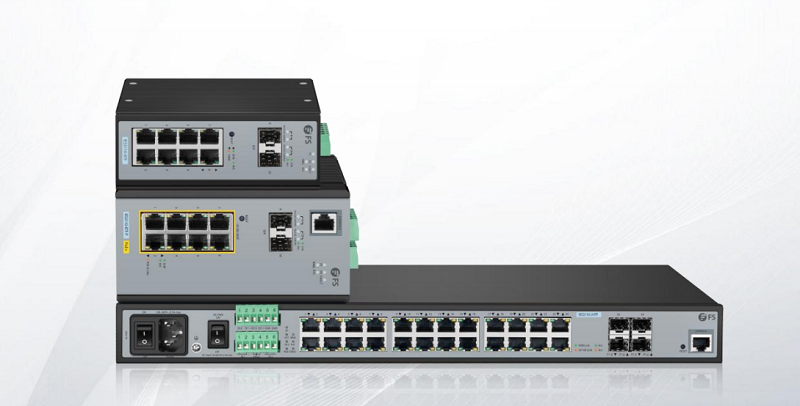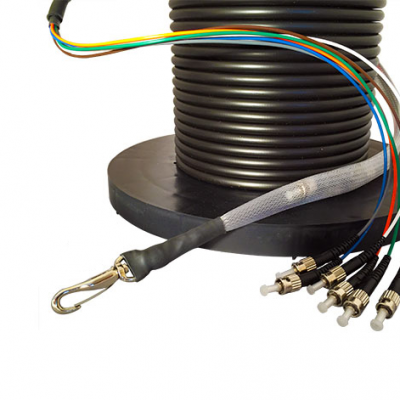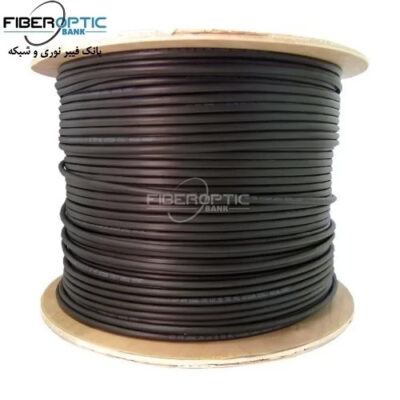Industrial Switch
Nowadays, industrial switch plays a vitally important role in various industries like energy, environmental protection, transportation, smart city surveillance, etc. And the demand for industrial switches is also increasing. In this post, you’ll have a comprehensive understanding of industrial switches.
What Is an Industrial Switch?
An industrial switch, also known as an industrial Ethernet switch, is a type of networking technology specifically designed for use in industrial settings. It provides reliable, high-speed data transmission for industrial networks, including 10G industrial switches for faster speeds. Typically, industrial Ethernet is a cost-effective and efficient way to manage communication between various types of industrial equipment.
Generally speaking, 10G industrial switches can withstand shocks, vibrations, and extreme temperature fluctuations from -40℃ to 75℃. So, you’ll find that the 10G industrial network switch contributes significantly to transportation, energy industries, and more.
What Are the Characteristics of Industrial Switch?
According to the functions and characteristics, industrial switches can be divided into unmanaged or managed industrial switches, industrial PoE switch or Non-PoE switch, Din-rail switch or rackmount switch, etc. Below are the main features of industrial ethernet switches.
Excellent Construction for Industrial Environments
Industrial switches usually adopt hardened construction like rugged enclosures with IP30, IP40, or higher-level protection ratings. Some network switches are even equipped with 6KV lightning protection to prevent damage from lightning in outdoor uses. With a rugged design, industrial network switches can deliver data at stably extreme temperatures from -40° to 75°C.
For example, one of the FS IES3100-8TF industrial switches is equipped with rugged IP30 aluminum metal housing. It can transmit data at extreme temperatures from -40° to 75°C as well as withstand a high degree of vibration and shock.
Fast Ring Network, Fast Redundancy
FS IES5100-24TF industrial Ethernet switch integrates the advanced ERPS (Ethernet Ring Protection Switching) technology and Spanning Tree Protocol (802.1s MSTP) into the industrial network, contributing to enhancing the system reliability in harsh conditions. In a certain simple Ring network, the recovery time of the data link can be as fast as 50ms.
Redundant Power Supply Design
The industrial network switch usually adopts dual power supply redundancy to avoid power failure, which accounts for a large proportion of industrial switch failure rates, guaranteeing a stable and reliable connection in harsh environments.
Flexible Mounting Options of DIN-rail and Wall Mounting
Most industrial switches are available in DIN-rail or wall mounting options for installation. For the option of DIN-rail, it’s ideal for efficient use of cabinet space in harsh environments. Besides, it also helps simplify installation. The DIN rail industrial switch can be easily attached to the long metal strips within a standard component rail-mounting system or a standard cabinet rack. Moreover, an industrial switch with DIN-rail mounting option does help in protecting sensitive electrical equipment.
Fanless Design
Industrial Ethernet switch generally uses a metal casing rather than a fan for faster heat dissipation. Fanless design for the industrial switch can minimize problems with dust and moisture ingress. In this regard, industrial switch ensures long-term reliability in industrial applications.
What Is an Industrial Switch Used for?
As mentioned above, the industrial ethernet switch provides high-performance and high-speed data transmission for industrial networks. Besides, it is also available in different speeds, ranging from 10G to 100G. Thus, industrial switches are used by companies for various reasons.
- Harsh Environmental Tolerance. With rugged design, the industrial ethernet switch is very durable and can work at extreme temperatures. They are ideal choices for harsh work environments, like oil and gas platforms, outdoor electrical applications, etc.
- Noise and Distraction Reduction. Fiber optic and twisted wire cables can both be supported by industrial Ethernet switches. Fiber optic cables are required for long-distance transmission because twisted wire cables can only transmit data across distances of up to 100 meters. In this case, industrial switches can lessen electrical noise and improve point-to-point network connections.
- Network Simplification. Unmanaged industrial switches are ideal for r entry-level, low-priority networks. They can provide fundamental packet filtering and support connectivity for five to ten ports at a relatively low price.
- Capabilities Enhanced. The managed industrial switch provides advanced network management tools, such as improved traffic filtering, network topography and device mapping, etc. Besides, they offer a high degree of network security and help you protect sensitive data passing through your network.
Applications of Industrial Switch
The regular Ethernet switch is not reliable enough to deliver data accurately in critical environments, while an industrial Ethernet switch with the above significant features can challenge the harsh conditions. Some typical applications for industrial Ethernet switches are as follows:
- Industrial switch in energy industries—–Take underground mine shafts for example, using an industrial Ethernet switch for underground coal mines can effectively block dust, dirt, and other particulate matter that might cause damage to the equipment.
- Industrial switch in transportation industries—–Industrial switch equipped with industrial-grade protection construction such as IP40, which can withstand high-intensity vibration and shock, and help you obtain data generated by moving objects.
- Industrial switches in electricity substations—–High electromagnetic interference is a big challenge for electricity substations, a robust, reliable, and secure harsh environment switch is the answer to solve this problem. Because industrial switch has strong anti-interference performance and can work in harsh electromagnetic environment, while commercial switch doesn’t support them.
- Industrial switch in smart city surveillance—–Using an industrial PoE switch to provide the required power for your PoE devices like IP cameras in smart city surveillance is a wise choice to monitor crowds and traffic. Get a powerful industrial network PoE switch to enjoy the benefits of simplified wiring and control of devices in an easier way.
What is the difference between industrial switches and normal switches?
Normal and industrial switches can vary in working temperature, Installation method, and application, etc.
- Appearance. Industrial switches typically use fanless designs and integrated metal shells to disperse heat. Normal switches generally have plastic or metal casings and a fan to remove heat.
- Working Temperature. Industrial Ethernet can operate in a large temperature range of -40 to 75 degrees Celsius, while a typical switch can only operate in a temperature range of 0 to 50 degrees Celsius.
- Application Scenario. Industrial switches are designed to meet the needs of industrial environments, providing reliable network connections between machines and other devices. Networks in homes or offices often employ standard network switches. They offer basic connectivity between devices on a single LAN.
- Installation Method. Industrial switches can be installed in a number of ways, including rack, flat desktop, wall-mounted, and DIN rail-mounted. Normal switches, however, are typically installed on a desktop or in a rack.
- Power Supply. In most cases, the industrial Ethernet switch offers a dual power supply backup. But the majority of normal switches on the market typically only support a single power supply.
Source: community.fs
Related products...
fiber-optic-cable
fiber-optic-cable
fiber-optic-cable

















[ratings]